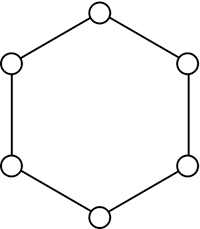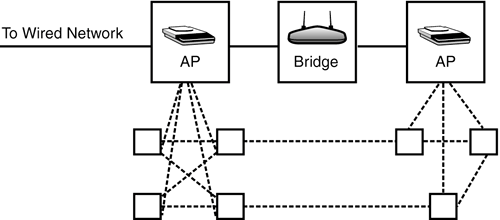Understanding Networks and Their Layouts
| Your office or home network might be small right now, but it might grow over time (which is what happened to me). This section explains some of the ways to look at larger, more complicated networks. This material is somewhat advanced and can be something to keep in the back of your mind when you are setting up your first Wi-Fi access point. But you might find that it provides a useful perspective even as you are getting started. The point of this section is to let you know what your options are as you start creating a wireless, or mixed wired and wireless network. After all, by the time you add computers for all your kids, an at home office, and wireless streaming media, you'll find that your network isn't so small anymore. So you don't have to worry about the material in this section when you are building your first wireless network with one or two computers. But you might want to think about it as your networks get more complex. The way that a network is laid out, or arranged, is called the network's topology. The term topology also refers to how the devices on the network communicate with each other. A network's physical topology is the way devices are laid out (meaning which devices are connected to each other, and so on). In contrast, a network's logical topology is the way that the signals act on the network media, meaning the way that the data passes through the network from one device to the next independent of the physical interconnection of the devices. If you diagrammed the physical and logical topology for a network, the diagram might look the same; but then again, it might not. I've already shown you some examples of network topologies. For example, the mesh pattern created by an ad hoc wireless network used by a number of devices is a network topology. Note In a true mesh topology, every node on the network is connected to every other node on the network. An infrastructure wireless network that uses an access point is operating in a star topology, as shown in the diagram in Figure 14.15. Figure 14.15. An infrastructure Wi-Fi network that uses an access point is an example of a star topology.
Two other common kinds of network topologies are the bus (see Figure 14.16) and the ring topologies, shown in Figure 14.17. In the bus topology, all the devices on the network are connected to a central cable or bus (also called backbone). Figure 14.16. In a bus topology, all devices are connected to a central cable, whereas in a ring topology, the devices are arranged in a loop so that each device communicates with the two devices next to it.
Figure 14.17. In a ring arrangement, the devices are arranged in a loop so that each device communicates with the two devices next to it.
In a ring topology, all the devices are connected to one another in the shape of a closed loop so that each device is directly connected to the two devices on either side of it, and only those two devices. (Does the ring topology "rule them all"?) Note Networks based on a star topology are probably easier to set up and manage than any other kind of network. As a practical matter, most even reasonably complex networks are hybrids that have features of a variety of topologies. For example, one common hybrid is called the tree topology, in which groups of star topology networks are placed along a bus-topology backbone. This is a common arrangement for Wi-Fi networks that cover a large area. Each Wi-Fi access point manages a star topology group, and the Wi-Fi access points are connected using a backbone. From the viewpoint of Wi-Fi, another interesting hybrid topology involves creating a full mesh network. Yes, as I explained at the beginning of the chapter, you can create a kind of mesh using Wi-Fi devices in ad hoc mode. But what you have isn't necessarily very reliable, and it also doesn't facilitate full mesh computing in which every device speaks to every other device. (The devices don't necessarily have to speak to each other at the same time, or in real time.) A useful Wi-Fi mesh network needs to be capable of responding to devices entering and leaving the network, operating with devices in infrastructure mode as well as ad hoc mode, and switching access points into bridges as required. Figure 14.18 shows what a mesh network of this sort might look like. Figure 14.18. A true Wi-Fi mesh network has a great many advantages.
A true Wi-Fi mesh network of the sort shown in Figure 14.18 has a great many advantages. It has no single point of failure and is therefore self-healing. This kind of network can easily get around obstaclessuch as water-laden foliage and barriers to sightlinesthat are problematic for other kinds of Wi-Fi networks. However, to work properly, a Wi-Fi mesh topology requires some specialized software that provides routing functionality and has the capability to operate in both infrastructure and ad hoc modes as required. Because of the benefits of Wi-Fi mesh networking, a lot of work is going on right now in this area. For an effort to bring Wi-Fi meshes to the third world using open source technology, you might be interested in the Wireless Roadshow project, http://thewirelessroadshow.org. Closer, perhaps, to home, a startup company named Firetide, Inc.http://www.firetide.com, based in Hawaiiis making the hardware and software needed to deploy robust true mesh topology Wi-Fi networks. And Mesh Networks, http://www.meshnetworks.com, claims to be the leading provider of high performance ad hoc networking products, including turnkey mesh network solutions. |
EAN: N/A
Pages: 204



